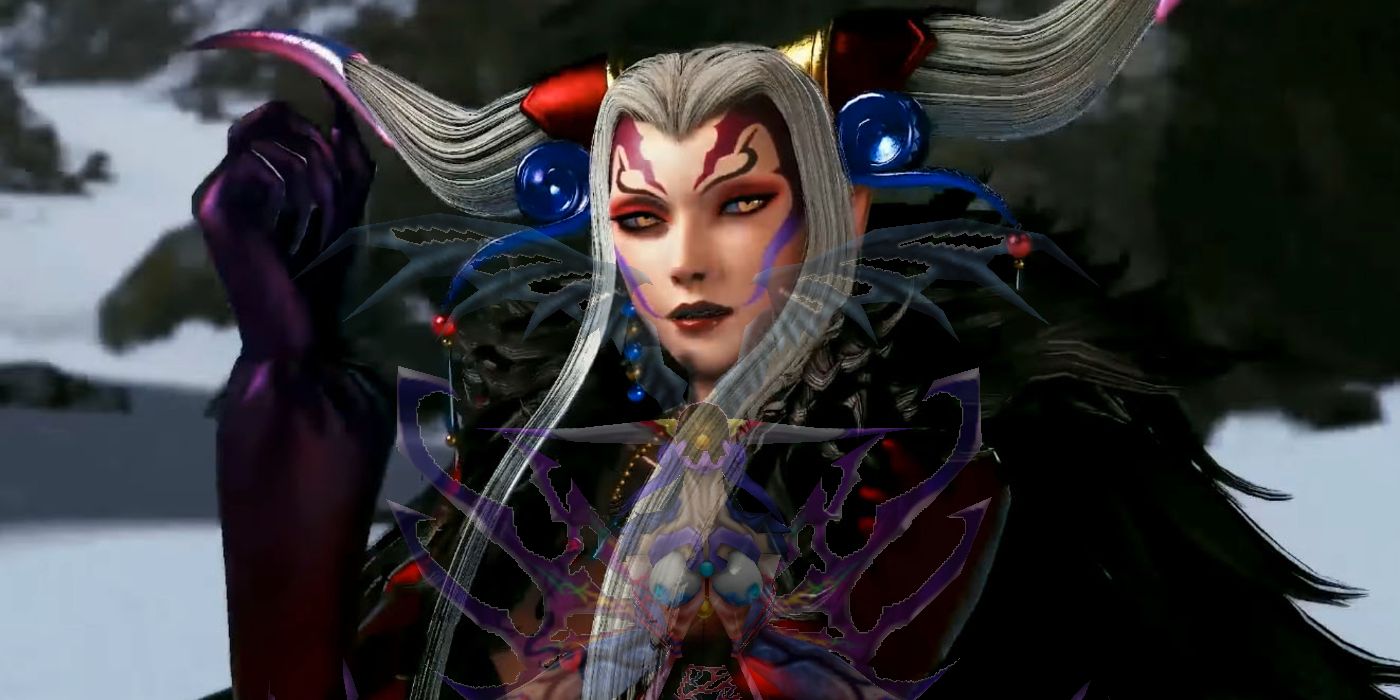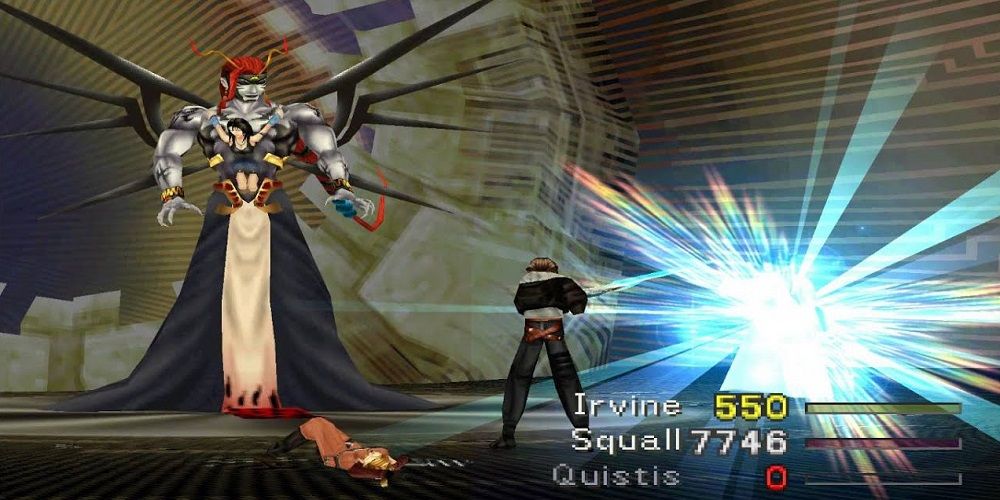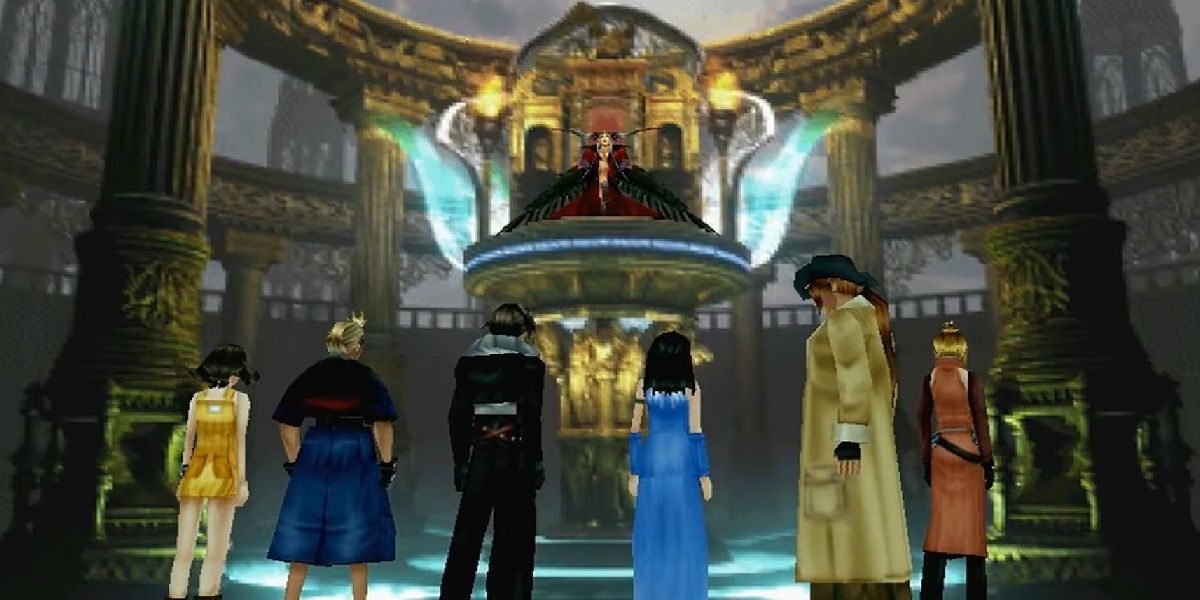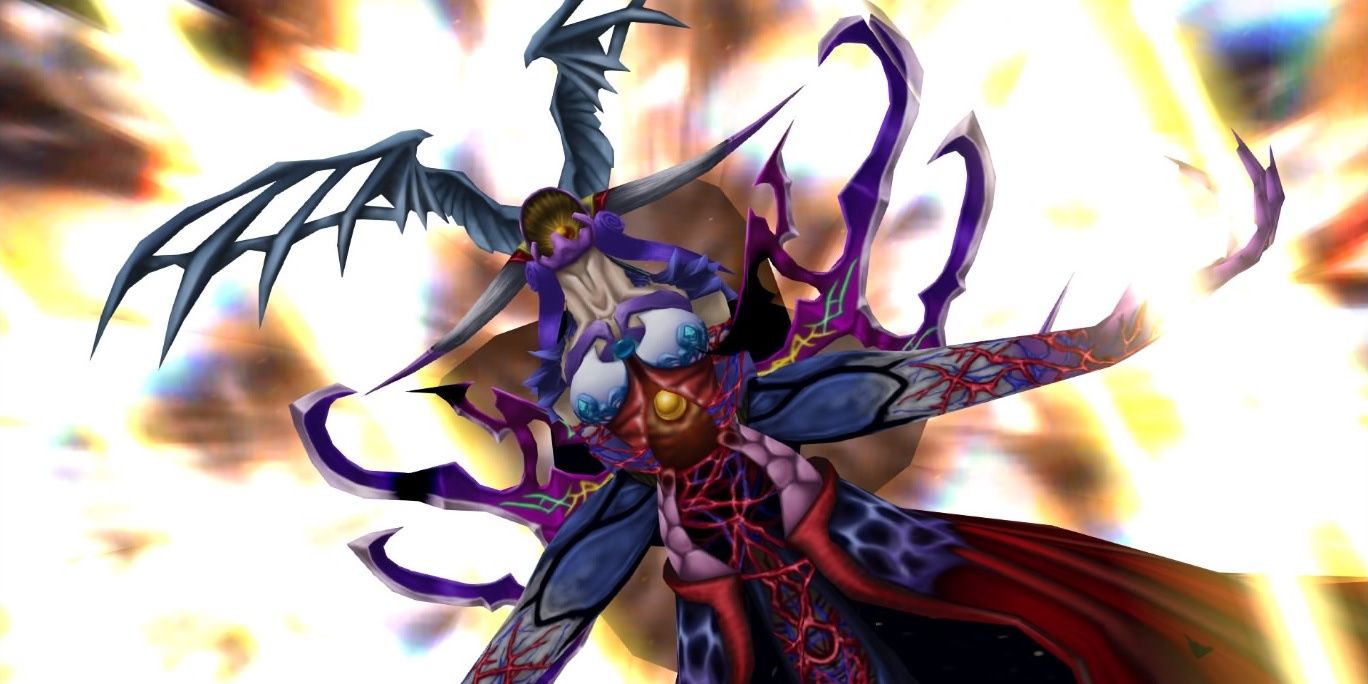
Final Fantasy 8’s story has an interesting reputation. The game is fondly remembered by some, and looked down upon by others. A common reason why is the phenomenon many fans have come to refer to as “Time Compression,” in which after Disc 1 things seem to start happening arbitrarily and make less sense. Plot points like the Lunar Cry flooding the world with monsters and the Sorceress Adel breaking loose are introduced, given a bit of attention, and then moved past. A lot of this can be attributed to Squaresoft’s deadlines tightening, and more staff members being pulled off of FF8 to work on FF9. Still, it does give the back half of Final Fantasy 8 a very distinct tone.
Speaking of time compression, the woman behind that is also the source of a lot of discussion. The Sorceress Ultimecia only shows up at the end of Final Fantasy 8, but her presence is felt throughout the game. By possessing the other Sorceresses, Ultimecia works on her plot to corrupt and destroy the world, and thwarts the heroic SeeDs for the duration of the story. Because FF3's Cloud of Darkness has no gender, Ultimecia is also Final Fantasy's first, and thus far only, female lead villain in a mainline game. Thanks to a recent impressive cosplay effort for the FF8 villain, some fans are taking notice of Ultimecia again. With an important place in FF's history and a compelling, unique design, it's understandable that some fans who just found out about her will want to know who she is.
RELATED: Why Final Fantasy 8 Deserves the Remake Treatment

Before one can understand who Ultimecia is, one must understand what she is. Sorceresses are women blessed - or cursed - with phenomenal magic powers. Legend in FF8's world says that they are humans gifted with natural magic power by the Great Hyne. It seems that, while there are not a great number in existence, their numbers remain fixed due to one's power transferring to an eligible human before death. Extensive usage of their magic seems to make them look less human, but no details on this process exist. Sometimes, Sorceresses take Knights to protect them, like Seifer and Squall for Ultimecia and Rinoa. Only four named Sorceresses are present in Final Fantasy 8 (Rinoa, Edea, Adel, and Ultimecia), and eleven generic ones appear in a boss fight during Time Compression.
The primary thing that separates a Sorceress from a regular mage is that, by default, humans are unable to use magic. Sorceresses have been observed manifesting all sorts of magical abilities that seem to differ based on their personality and interests, but humans can't. This, combined with some of FF8's most heinous historical criminals being Sorceresses, has caused a schism between them and average people. Every known Sorceress is persecuted for their powers and must either retreat from society, stand up against it, or, in the case of at least one unnamed Sorceress, stand up for the common folk. A recent Sorceress, implied to be Edea, also helped Dr. Odine develop Para-Magic, which any human can use. Para-Magic encompasses the controversial Drawing and Junctioning mechanics. It could be said that a lot of Final Fantasy 8's history revolves around Sorceresses, and that phrase becomes quite literal when Ultimecia steps in.
RELATED: Final Fantasy 8: 10 Things You Didn't Know About SeeD

Much of Ultimecia's personality and backstory is communicated through inference, as she doesn't talk much about herself. It seems that Ultimecia suffered through persecution for being a Sorceress, and wants to erase all of humanity for it. She harbors a special hatred for SeeDs because of a prophecy referring to a "legendary SeeD" coming to strike her down. To subsume all of time and space and remake the world in her image, Ultimecia needs to be able to cast a time compression spell at an early point in history. Using a machine called the Junction Machine Ellone that is set up in Ultimecia's castle, she sends her mind back in time. Ultimecia possesses Sorceresses living in the same era as the machine's human equivalent, a girl named Ellone, and then forces her to send Ultimecia back even further.
Not much else is known about Ultimecia as a character. Her powers reflect her goal of controlling all of time and space, and her tendency to see all other living beings as tools. One of Final Fantasy 8's memorable scenes involves her magically charming the nation of Galbadia, verbally abusing its people as her acceptance speech, and then murdering the current president to gain absolute power. Ultimecia also shows a preference for using the most powerful individuals she can. She predicts that Seifer will be a powerful ally if she enthralls him, and uses most of her time controlling Rinoa to possess the more powerful tyrant Sorceress Adel. She is ruthless, powerful, and smart enough to force the heroes to allow a partial Time Compression just to defeat her.

The Sorceress Ultimecia strikes a demonic figure, with hair styled as horns, jet black wings, clawed hands and feet, and even the ability to manifest a person's deepest fears as a powerful monster. She is also motivated by hate, and hates Squall for being the "legendary SeeD" prophesied to defeat her. This is in direct contrast with Rinoa, Squall's lover and a kindhearted young girl who manifests golden wings when using her Sorceress powers. Rinoa is also associated with her dog Angelo, while Ultimecia creates the lion-like Guardian Force Griever during the final battle. This connection is so strong that fans have theorized that Ultimecia is secretly Rinoa from the distant future, driven mad by her friends' mortality and persecution from society. FF8 director Yoshinori Kitase has stated this theory is not true, however, and that their similarities can be chalked up to both being Sorceresses.
Also of note is Ultimecia's English name. It recalls a sense of finality, fitting for a witch who dwells at the end of time. However, that may not have been Squaresoft's intent. The Japanese, Spanish, Italian, and German translations are all roughly "Artemisia," in reference to the Greek goddess Artemis, several prominent European and Asian women, and a typical Italian name for sorceresses. The original Japanese name of the spell Ultima is Arutema, and Ultimecia's name is Arutimishia, so it could go either way. This is just another wrinkle contributing to one of Final Fantasy's more atypical villains, leading to both Ultimecia and Final Fantasy 8 generating fan discussion to this very day.
Final Fantasy 8 Remastered is available now on PC, PS4, Switch, and Xbox One.
MORE: Final Fantasy 8: Every Party Member Ranked According To Design

